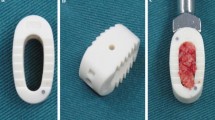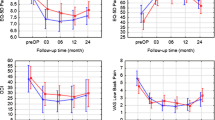Abstract
Background
Low back pain and sciatica represent a common disabling condition with a significant impact on the social, working and economic lives of patients. Transforaminal lumbar interbody fusion (TLIF) is a surgical procedure used in degenerative spine conditions. Several types of cages were used in the TLIF procedure.
Purpose
To determine whether there is a difference in terms of symptomatology improvement, return to daily activities and fusion rate between metal cages and polyetheretherketone (PEEK) cages.
Methods
We have retrospectively reviewed 40 patients who have undergone TLIF from October 2015 to May 2016. All patients were clinically evaluated with questionnaires and were assessed with CT scan and standing X-ray films of the full-length spine.
Results
We found no significant functional differences in the two groups. At 1-year follow-up, osteolysis was present in 50% of cases of the PEEK cages and in 10% cases of the metal cages. The degree of fusion at 1 year was evaluated as complete in 40% cases of the metal cages and 15% cases of the PEEK cages.
Conclusions
We have found a better fusion rate and prevalence of fusion in the group treated with metal cages, reflecting the well-known osteoinductive properties of titanium and tantalum.




Similar content being viewed by others
References
Buchbinder R, Underwood M (2012) Prognosis in people with back pain. Can Med Assoc J 184(11):1229–1230. https://doi.org/10.1503/cmaj.120627
Wigfield CC, Nelson RJ (2001) Nonautologous interbody fusion materials in cervical spine surgery: how strong is the evidence to justify their use? Spine (Phila Pa 1976) 26(6):687–694
McKenna PJ, Freeman BJC, Mulholland RC, Grevitt MP, Webb JK, Mehdian SH (2005) A prospective, randomised controlled trial of femoral ring allograft versus a titanium cage in circumferential lumbar spinal fusion with minimum 2-year clinical results. Eur Spine J 14(8):727–737. https://doi.org/10.1007/s00586-005-1034-z
Brantigan JW, Steffee AD, Lewis ML, Quinn LM, Persenaire JM (2000) Lumbar interbody fusion using the Brantigan I/F cage for posterior lumbar interbody fusion and the variable pedicle screw placement system: two-year results from a Food and Drug Administration investigational device exemption clinical trial. Spine (Phila Pa 1976) 25(11):1437–1446
Cutler AR, Siddiqui S, Mohan AL, Hillard VH, Cerabona F, Das K (2006) Comparison of polyetheretherketone cages with femoral cortical bone allograft as a single-piece interbody spacer in transforaminal lumbar interbody fusion. J Neurosurg Spine 5(6):534–539. https://doi.org/10.3171/spi.2006.5.6.534
Cabraja M, Oezdemir S, Koeppen D, Kroppenstedt S (2012) Anterior cervical discectomy, and fusion: comparison of titanium and polyetheretherketone cages. BMC Musculoskelet Disord 13(1):172. https://doi.org/10.1186/1471-2474-13-172
Chou Y-C, Chen D-C, Hsieh WA et al (2008) Efficacy of anterior cervical fusion: comparison of titanium cages, polyetheretherketone (PEEK) cages, and autogenous bone grafts. J Clin Neurosci 15(11):1240–1245. https://doi.org/10.1016/j.jocn.2007.05.016
Nemoto O, Asazuma T, Yato Y, Imabayashi H, Yasuoka H, Fujikawa A (2014) Comparison of fusion rates following transforaminal lumbar interbody fusion using polyetheretherketone cages or titanium cages with transpedicular instrumentation. Eur Spine J 23(10):2150–2155. https://doi.org/10.1007/s00586-014-3466-9
Christensen FB, Laursen M, Gelineck J, Eiskjaer SP, Thomsen K, Bünger CE (2001) Interobserver and intraobserver agreement of radiograph interpretation with and without pedicle screw implants: the need for a detailed classification system in posterolateral spinal fusion. Spine (Phila Pa 1976) 26(5):538–543
Knox CJB, Dai CJM, Orchowski LJ (2011) Osteolysis in transforaminal lumbar interbody fusion with bone morphogenetic protein-2. Spine (Phila Pa 1976) 36(8):672–676. https://doi.org/10.1097/brs.0b013e3181e030e0
Medici A, Meccariello L, Falzarano G (2014) Non-operative vs. percutaneous stabilization in Magerl’s A1 or A2 thoracolumbar spine fracture in adults: is it really advantageous for a good alignment of the spine? Preliminary data from a prospective study. Eur Spine J 23(Suppl 6):677–683. https://doi.org/10.1007/s00586-014-3557-7
Meccariello L, Muzii VF, Falzarano G, Medici A, Carta S, Fortina M, Ferrata P (2017) Dynamic corset versus three-point brace in the treatment of osteoporotic compression fractures of the thoracic and lumbar spine: a prospective, comparative study. Aging Clin Exp Res 29(3):443–449. https://doi.org/10.1007/s40520-016-0602-x
Vadapalli S, Sairyo K, Goel VK et al (2006) Biomechanical rationale for using polyetheretherketone (PEEK) spacers for lumbar interbody fusion-A finite element study. Spine (Phila Pa 1976) 31(26):E992–E998. https://doi.org/10.1097/01.brs.0000250177.84168.ba
Wu S-H, Li Y, Zhang Y-Q et al (2013) Porous titanium-6 aluminum-4 vanadium cage has better osseointegration and less micromotion than a poly-ether-ether-ketone cage in sheep vertebral fusion. Artif Organs 37(12):E191–E201. https://doi.org/10.1111/aor.12153
Schimmel JJP, Poeschmann MS, Horsting PP, Schönfeld DHW, van Limbeek J, Pavlov PW (2016) PEEK cages in lumbar fusion: mid-term clinical outcome and radiological fusion. J Spinal Disord Technol. https://doi.org/10.1097/bsd.0b013e31826eaf74
Olivares-Navarrete R, Gittens RA, Schneider JM et al (2012) Osteoblasts exhibited a more differentiated phenotype and increased bone morphogenetic protein production on titanium alloy substrates than on poly-ether-ether-ketone. Spine J 12(3):265–272. https://doi.org/10.1016/j.spinee.2012.02.002
Cortesi PA, Assietti R, Cuzzocrea F et al (2017) Epidemiologic and economic burden attributable to first spinal fusion surgery. Spine (Phila Pa 1976). https://doi.org/10.1097/brs.0000000000002118
Author information
Authors and Affiliations
Corresponding author
Ethics declarations
Conflict of interest
All authors declare that they have no conflict of interest.
Ethical approval
This article does not contain any studies with human participants or animals performed by any of the authors.
Rights and permissions
About this article
Cite this article
Cuzzocrea, F., Ivone, A., Jannelli, E. et al. PEEK versus metal cages in posterior lumbar interbody fusion: a clinical and radiological comparative study. Musculoskelet Surg 103, 237–241 (2019). https://doi.org/10.1007/s12306-018-0580-6
Received:
Accepted:
Published:
Issue Date:
DOI: https://doi.org/10.1007/s12306-018-0580-6




